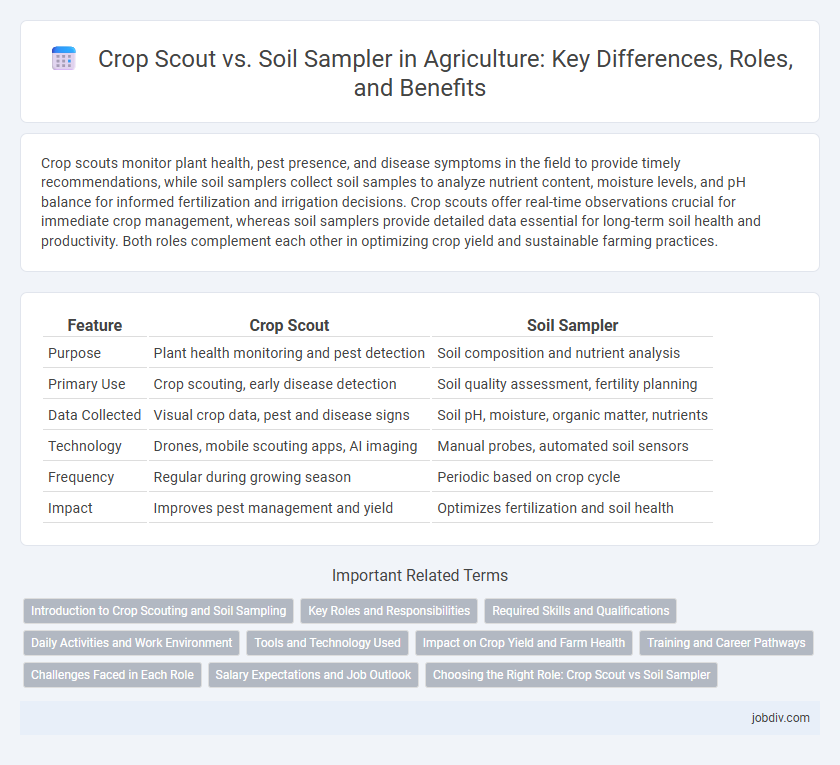Crop scouts monitor plant health, pest presence, and disease symptoms in the field to provide timely recommendations, while soil samplers collect soil samples to analyze nutrient content, moisture levels, and pH balance for informed fertilization and irrigation decisions. Crop scouts offer real-time observations crucial for immediate crop management, whereas soil samplers provide detailed data essential for long-term soil health and productivity. Both roles complement each other in optimizing crop yield and sustainable farming practices.
Table of Comparison
| Feature | Crop Scout | Soil Sampler |
|---|---|---|
| Purpose | Plant health monitoring and pest detection | Soil composition and nutrient analysis |
| Primary Use | Crop scouting, early disease detection | Soil quality assessment, fertility planning |
| Data Collected | Visual crop data, pest and disease signs | Soil pH, moisture, organic matter, nutrients |
| Technology | Drones, mobile scouting apps, AI imaging | Manual probes, automated soil sensors |
| Frequency | Regular during growing season | Periodic based on crop cycle |
| Impact | Improves pest management and yield | Optimizes fertilization and soil health |
Introduction to Crop Scouting and Soil Sampling
Crop scouting involves systematic field observations to monitor crop health, pest presence, and nutrient deficiencies, enabling targeted management decisions. Soil sampling collects representative soil portions to analyze nutrient levels, pH, and texture, informing precise fertilizer applications for optimal crop growth. Both practices are essential in precision agriculture, improving yield potential and resource efficiency by integrating crop condition data with soil fertility information.
Key Roles and Responsibilities
Crop scouts monitor crop health by identifying pests, diseases, and nutrient deficiencies, providing crucial data for timely intervention and crop management decisions. Soil samplers collect and analyze soil samples to assess nutrient levels, pH, and moisture content, enabling precise soil fertility management and optimizing crop yield. Both roles collaborate to enhance agricultural productivity through targeted, data-driven strategies.
Required Skills and Qualifications
Crop Scouts require strong observational skills, knowledge of plant pathology, pest identification, and expertise in using GPS and data collection tools to monitor crop health effectively. Soil Samplers need proficiency in soil science, accurate sampling techniques, and the ability to operate soil sampling equipment, alongside understanding laboratory protocols for analysis. Both roles demand attention to detail and fieldwork experience, but Crop Scouts emphasize biological assessment skills, whereas Soil Samplers focus on technical soil evaluation and data precision.
Daily Activities and Work Environment
Crop scouts primarily conduct field inspections, monitoring plant health, pest activity, and disease symptoms to provide real-time data for crop management decisions. Soil samplers focus on collecting soil samples at various depths across fields, analyzing nutrient content, pH levels, and moisture to guide fertilization and irrigation strategies. Both roles require extensive outdoor work, often in varying weather conditions, with crop scouts spending more time on visual assessments and soil samplers emphasizing precise sampling techniques.
Tools and Technology Used
Crop scouting employs handheld devices like tablets equipped with GPS and specialized apps to monitor crop health, pest activity, and nutrient levels in real-time. Soil samplers utilize tools such as augers, probes, and core samplers to collect soil samples for laboratory analysis, enabling precise assessment of soil composition, moisture, and nutrient content. Integration of remote sensing technologies and IoT sensors enhances data accuracy and facilitates informed decision-making in both crop scouting and soil sampling processes.
Impact on Crop Yield and Farm Health
Crop scouts identify pest infestations and nutrient deficiencies early, enabling targeted interventions that prevent yield loss and improve overall crop health. Soil samplers provide precise data on soil nutrient levels and pH, allowing for optimized fertilizer application and better soil management, directly enhancing crop productivity. Integrating crop scouting and soil sampling ensures timely pest control and balanced soil nutrition, maximizing yield and sustaining long-term farm health.
Training and Career Pathways
Crop Scouts specialize in monitoring field conditions, pest activity, and crop health, requiring training in agronomy, pest management, and data analysis, leading to careers in precision agriculture and crop management. Soil Samplers undergo education focused on soil science, sampling techniques, and environmental compliance, preparing them for roles in soil testing labs, agronomy consulting, and environmental monitoring. Both career paths offer growth opportunities in sustainable farming practices and agricultural research, emphasizing specialized technical skills and field expertise.
Challenges Faced in Each Role
Crop Scouts face challenges such as identifying early signs of pest infestations and diseases across diverse crop types while working under unpredictable weather conditions that can obscure symptoms. Soil Samplers encounter difficulties in collecting representative soil samples from uneven terrain and varying soil compositions, which can affect the accuracy of nutrient analysis. Both roles require precise timing and attention to detail to ensure data quality, but Crop Scouts must interpret dynamic plant health indicators, whereas Soil Samplers focus on consistent sampling methodology.
Salary Expectations and Job Outlook
Crop Scouts typically earn an average salary ranging from $30,000 to $45,000 annually, with opportunities for growth depending on experience and region. Soil Samplers command salaries around $35,000 to $50,000 per year, reflecting the technical skills required for soil analysis and sampling. The job outlook for both roles is positive, driven by increasing demand for sustainable farming practices and precision agriculture technologies.
Choosing the Right Role: Crop Scout vs Soil Sampler
Choosing the right role between Crop Scout and Soil Sampler depends on the specific agricultural needs and data requirements. Crop Scouts specialize in monitoring plant health, pest activity, and disease symptoms to provide timely interventions that enhance crop yield and quality. Soil Samplers focus on collecting and analyzing soil samples to assess nutrient levels, pH balance, and soil texture, guiding precise fertilizer application and soil management strategies.
Crop Scout vs Soil Sampler Infographic

 jobdiv.com
jobdiv.com